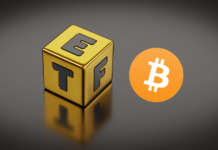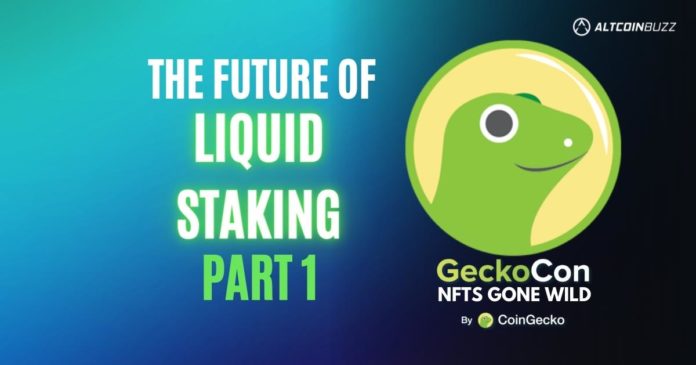Liquid staking is when you stake a token and then receive a new token that represents the staked asset. Now you can use this new token in DeFi. This is an up-and-coming strategy that is getting widely used. In this presentation from GeckoCon 2022, the moderator and panelists look at the future of liquid staking.
Liquid staking is an innovative option to staking. It sidesteps risks associated with illiquidity and centralization. In this article, we assume that you understand the basics of liquid staking (LS). So, let’s have a look what liquid staking has in store for us. We detail the opinions given by the panelists during the presentation.
Who Is in the Panel?
- Cole Kennelly, the moderator, is the Founder and CEO of Volmex Labs.
- Filipe Gonçalves, Chief of DeFi at Ankr.
- Amitej Gajjala is the CEO and Co-Founder of Stader Labs.

What Kind of Liquid Staking Does Your Company Offer? What Makes It Compelling and Unique?
Amitej
There are three pillars of liquid staking which Stader Labs provides.
- More capital efficiency
- It helps networks to decentralize
- Cross chain utility of the staked assets
Filipe
The first utility was with staked ETH. Ankr has two versions of liquid staking.
- Reward bearing
- Reward earning with rebase
The rebase makes it easier to trade because the redemption value is always 1:1. That’s of course with the underlying asset. However, you receive more liquid tokens. But, they are more difficult to integrate with a DeFi protocol. You can use arbitrage opportunities on the BNB Chain between the two tokens. Ankr also has its own bridge to bridge all tokens. Currently, with Ethereum and Polygon, but they plan to add more chains.
There’s also a native bridge in the making. This allows you to receive staking rewards directly. There’s no need to transfer them, and it saves on gas fees. In the future, they plan to use liquid staking as an infrastructure.
Are There Any Obstacles for Liquid Staking in the Upcoming Years So It Can Move Towards Mass Adaption?
Filipe
He sees the main issue as the capital and efficiencies with stable swap DEXes. By design, when providing liquidity to LS, for instance BNB LS and BNB, half of the pool isn’t staked. We need to overcome this for somebody who just wants to stake.
The market expects trading fees and farming rewards to make up for this. This needs more capital efficiency. One option is to lend more BNB. However, this depends too much on farming rewards. It’s an obstacle to make people give liquidity for LS. There’s the same issue with stablecoins in general. There’s the smart contract risk with other smart contracts. Especially for institutional investors. We need to overcome this, since it may hold them back.

Amitej
Liquid staking will transform retailer and business consumer segments.
Business consumer segment.
If they switch a custodian, they need to unstake their assets. Once they find an appropriate validator, they need to stake again. If they have an LS token, switching costs between custodians or wallets change. It is easy and capital efficient.
Retail segment.
They are more interested in farming rewards. They show less interest in holding an asset for price appreciation. LS tokens give them better deals than just staking their native asset. This will provide for deeper liquidity in the future. As a result, AMMs may become more capital efficient.
Liquid Staking Is in Tech Adoption, When and How Will It Achieve Critical Mass?
Amitej
Adoption of liquid staking is still nascent. Some reasons are:
- It may be an auxiliary (for tax reasons).
- Many large funds don’t have the right know-how of DeFi. So, LS doesn’t make sense to them.
He still believes that LS will prevail in the future, with more utility.
Filipe
He agrees that LS is still early. If large funds want exposure to staking, they can’t avoid LS. Especially CeFi firms. Institutional investors may for now not see the risk vs. reward balance. They may join during a later stage of the adoption cycle.
Is LS Only Crypto-Native, or Are There Non-Crypto Large Funds Involved?
Filipe
Institutions like Swiss Borg want instant liquidity. They worked with stETH, but they can’t unstake that for now. As a non-redeemable token, he’s not surprised it de-pegged. It’s now at a 20% discount sale if you are patient enough.
Web3 DEXes will be the first to adopt, since they’re already in DeFi. They can just integrate LS, they don’t need to offer their own. Swiss Borg, BlockFi, and the like are next in line. They will see that other LS tokens are easier to redeem and have a lot less liquidity risk. Portfolio trackers can also join. They have an earn section in which they can integrate LS.
There’s a Part 2 of this presentation where you can read the rest of the discussion.
⬆️For more cryptocurrency news, check out the Altcoin Buzz YouTube channel.
⬆️Find the most undervalued gems, up-to-date research, and NFT buys with Altcoin Buzz Access. Join us for $99 per month now.



























